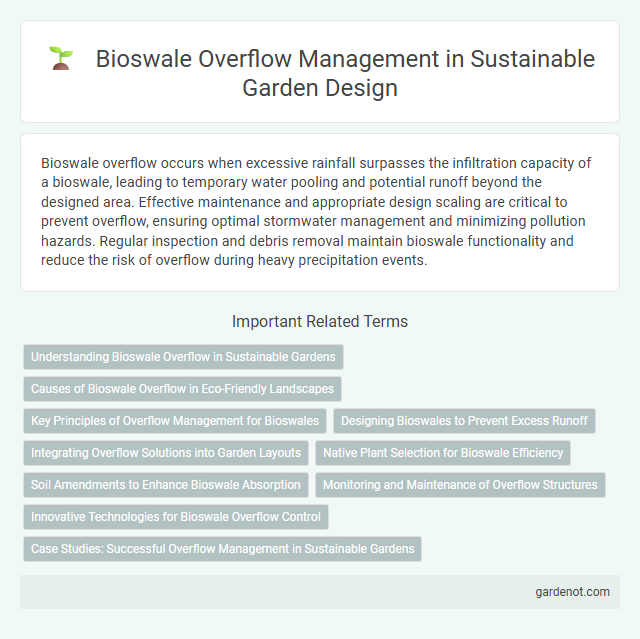Bioswale overflow occurs when excessive rainfall surpasses the infiltration capacity of a bioswale, leading to temporary water pooling and potential runoff beyond the designed area. Effective maintenance and appropriate design scaling are critical to prevent overflow, ensuring optimal stormwater management and minimizing pollution hazards. Regular inspection and debris removal maintain bioswale functionality and reduce the risk of overflow during heavy precipitation events.
Understanding Bioswale Overflow in Sustainable Gardens
Bioswale overflow occurs when the water infiltration capacity is exceeded due to heavy rainfall or poor maintenance, leading to surface runoff. Proper design incorporating adequate sizing, permeable soil media, and vegetation helps manage overflow effectively in sustainable gardens. Monitoring and regular sediment removal optimize bioswale functionality, reducing flooding and improving water quality.
Causes of Bioswale Overflow in Eco-Friendly Landscapes
Bioswale overflow in eco-friendly landscapes is primarily caused by excessive rainfall exceeding the bioswale's designed infiltration capacity. Soil compaction and poor maintenance reduce permeability, impeding water absorption and leading to surface runoff. Inadequate sizing and improper vegetation selection further compromise the bioswale's ability to manage stormwater effectively.
Key Principles of Overflow Management for Bioswales
Bioswale overflow management emphasizes maintaining optimal infiltration rates and ensuring adequate storage capacity to prevent surface runoff. Key principles include designing bioswales with appropriate soil media, vegetation, and grading to enhance water absorption and delay peak discharge during heavy rainfall. Incorporating overflow outlets and spillways facilitates controlled release, reducing erosion and protecting downstream water quality.
Designing Bioswales to Prevent Excess Runoff
Designing bioswales to prevent excess runoff involves optimizing soil composition, vegetation selection, and slope gradients to maximize water infiltration and reduce overflow risk. Incorporating layered soil profiles with high permeability and native deep-rooted plants enhances absorption capacity and filtration efficiency. Properly sizing bioswales based on watershed area and expected stormwater volume further minimizes overflow while improving urban stormwater management.
Integrating Overflow Solutions into Garden Layouts
Integrating overflow solutions into garden layouts enhances the functionality of bioswales by managing excess stormwater during heavy rainfall, preventing flooding and soil erosion. Designing strategic overflow channels and incorporating permeable surfaces redirect surplus water safely to designated areas, maintaining plant health and soil stability. Utilizing native vegetation in overflow zones supports water absorption and filtration, optimizing the bioswale's ecological benefits while preserving garden aesthetics.
Native Plant Selection for Bioswale Efficiency
Native plant selection plays a critical role in preventing bioswale overflow by enhancing soil infiltration and water absorption capacity. Deep-rooted native species such as switchgrass (Panicum virgatum) and blue flag iris (Iris versicolor) improve groundwater recharge and reduce surface runoff during heavy rainfall events. Integrating diverse native plants increases resilience and promotes sustained bioswale efficiency under varying hydrological conditions.
Soil Amendments to Enhance Bioswale Absorption
Soil amendments such as compost, biochar, and engineered organic matter significantly improve bioswale infiltration rates by increasing soil porosity and water-holding capacity, reducing overflow during heavy rainfall events. Enhanced microbial activity from these amendments promotes soil aggregation, leading to better absorption and nutrient retention within the bioswale system. Regular incorporation of these materials mitigates surface runoff, ensuring efficient stormwater management and preventing localized flooding.
Monitoring and Maintenance of Overflow Structures
Bioswale overflow can lead to ineffective stormwater management and potential flooding hazards. Regular monitoring using flow sensors and visual inspections is essential to detect blockages or structural damage in overflow channels. Proactive maintenance, including sediment removal and vegetation management, ensures optimal performance and reduces the risk of overflow during heavy rainfall events.
Innovative Technologies for Bioswale Overflow Control
Innovative technologies for bioswale overflow control include real-time monitoring sensors that detect water levels and trigger automated diversion systems to prevent flooding. Permeable materials combined with smart drainage infrastructure enhance water infiltration while managing excess runoff during heavy rainfall. Advanced modeling software optimizes bioswale design to improve overflow capacity and ensure sustainable urban water management.
Case Studies: Successful Overflow Management in Sustainable Gardens
Bioswale overflow management is critical in sustainable gardens to prevent flooding and waterlogging. Case studies demonstrate effective strategies such as the integration of overflow spillways and overflow detention basins that redirect excess water safely during heavy rainfall events. These approaches enhance the bioswale's capacity to manage stormwater sustainably while maintaining plant health and soil integrity.
Bioswale overflow Infographic

 gardenot.com
gardenot.com